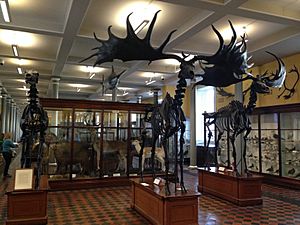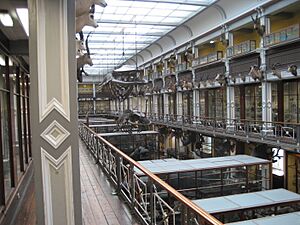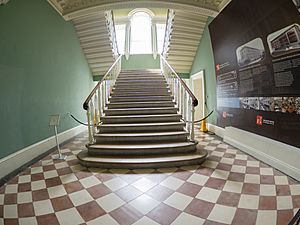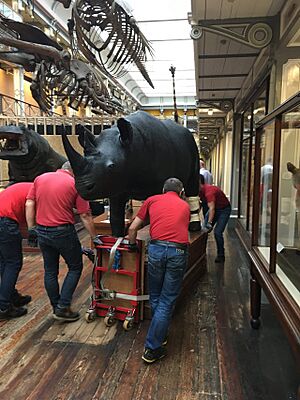National Museum of Ireland – Natural History facts for kids
| Ard-Mhúsaem na hÉireann – Stair an Dúlra | |
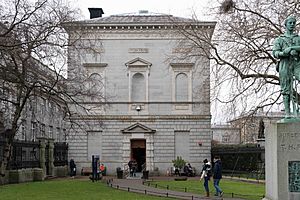
Entrance to the museum
|
|
| Lua error in Module:Location_map at line 420: attempt to index field 'wikibase' (a nil value). | |
| Established | 1856 |
|---|---|
| Location | Merrion Street, Dublin, Ireland |
| Type | National museum |
| Visitors | 387,412 |
| Public transit access | St Stephen's Green Dublin Pearse Dublin Bus routes: 25, 25a, 44, 61, 66, 67 |
| National Museum of Ireland network | |
|
|
The National Museum of Ireland – Natural History is a super cool place in Dublin, Ireland. People sometimes call it the Dead Zoo because it's full of amazing animals that are no longer alive, like skeletons and stuffed creatures! It's part of the National Museum of Ireland family.
This museum first opened its doors way back in 1856. It was built to show off collections from the Royal Dublin Society. Over time, the building and its incredible collection of animals were given to the Irish government.
The museum has a huge collection of animals and some geological items. The animal collection, and the building itself, haven't changed much since the Victorian era. This means it feels like stepping back in time! It's like a "museum of a museum" because it still looks like it did over 100 years ago.
It's free to visit, which is awesome! Lots of people come to see it, with hundreds of thousands visiting each year. The museum closed for a while in November 2020 for big renovations. The ground floor reopened in August 2022, but the museum is still undergoing major work to make it even better for visitors in the future.
Contents
What You Can See: The Collections
The Natural History Museum has over 2 million items! Most of these are animals, including a million insects. There used to be a collection of plants too, but those moved to the National Botanic Gardens in 1970.
Like many museums, most of the items aren't on display. For example, almost all the geological (rock and fossil) collections are kept safely in storage. In 1962, a building that held the main geological displays was taken down. This meant those collections had to be put into storage, and most are still there today. However, some geological items were shown in a special exhibition at the National Museum of Ireland site at Collins Barracks, which opened in September 2021.
Many scientists have studied the museum's collections. A famous scientist named Stephen Jay Gould even wrote an essay about the Irish elk that you can see here!
Exploring the Museum's Displays
The museum building is designed like a "cabinet of curiosities." It's meant to show off a huge collection of animals from all over the world. It really hasn't changed much in over a century! About 10,000 specimens are on display. You can even find a virtual tour of the museum online, which shows what it looked like before the big renovation work started.
The Irish Room: Animals from Ireland
The ground floor is called the Irish Room. Here, you'll find animals that live or once lived in Ireland. The most famous displays are the huge skeletons of giant Irish deer. Their massive antlers are incredible! Many skulls of these and other deer line the walls.
You'll also see stuffed and mounted mammals, birds, fish, and even insects that are native to Ireland. Many of these animals, like badgers, hares, and foxes, are over a hundred years old! Look up, and you'll see a basking shark hanging from the ceiling. This special grouping of Irish animals in one room started in 1910.
Animals from Around the World
The first floor is where you'll discover mammals from all over the globe. This includes animals that are now extinct (no longer alive) or endangered species (at risk of disappearing). You can see a thylacine (a Tasmanian tiger) and a pygmy hippopotamus. There's also a polar bear that was shot by Admiral Sir Francis Leopold McClintock. Many of the mounted animals were bought from or given by the Royal Zoological Gardens, Dublin. A large collection of Irish birds, given by Richard Barrington, is displayed along one wall.
Upper Galleries: Birds and Sea Creatures
The Lower gallery has been closed to visitors since 2007. It contains bird specimens from around the world. Above this, from the second ceiling, hang the skeletons of a humpback whale and a fin whale. This floor also has a skeleton of a dodo, a famous extinct bird from Mauritius.
The Upper gallery is also closed since 2007. It displays invertebrates (animals without backbones) and marine (sea) specimens. This includes the museum's collection of Glass Sea Creatures. These amazing glass models were made by famous artists Leopold and Rudolf Blaschka. You can also see many "game heads" (trophies) mounted on pillars, which were given to the museum in the 1930s.
Museum History: A Look Back in Time
Early Days: 1786–1850s
The museum's collections started growing in the late 1700s. In 1792, the Royal Dublin Society bought a huge collection from Nathaniel Gottfried Leske, which was one of Europe's biggest natural history collections at the time. A professor named Karl Ludwig Giesecke then added even more items by traveling around Ireland and places like Greenland.
The museum, located in Leinster House, opened to the public a couple of days a week starting in 1832. People wanted more access, so in 1836, a special committee decided a bigger building was needed. By 1850, 44,000 people were visiting, and it was clear the museum was too small for everyone!
Alexander Carte became the curator (manager) and director of the museum. He helped the collections grow, aiming to show more types of animals and rocks from Ireland and around the world. He also started organizing the exhibits by where the animals came from.
Building the Museum: 1850s–1870s
In 1853, plans began for the new museum building. The government gave money for it, and the public also helped raise funds. This led to the building you see today! It was built as an extension to Leinster House, where the Royal Dublin Society was based.
The building was designed by architect Frederick Clarendon. It was made to match the National Gallery of Ireland, which is on the other side of the lawn. The inside frame is made of cast iron, and the outside uses granite and Portland stone.
The first stone was laid on March 15, 1856, and the building was finished in 1857. It was connected to Leinster House by a beautiful walkway. This allowed visitors to move easily between the buildings.
The new museum opened in August 1857. Famous explorer David Livingstone even gave a lecture there! The first exhibits included plants, fossils, birds, and insects.
By 1867, the museum was open four days a week and even two evenings a week. In 1870, over 100,000 people visited!
Becoming a National Museum: 1870s–1920
From 1868 to 1876, the government started planning to create national science and art institutions in Ireland. They wanted to have a Science and Art Museum, a National Gallery, a National Library, and museums for Natural History and Irish history, all in one area.
On August 14, 1877, the museum and its collections officially became owned by the government. The new institution was called the Museum of Science and Art, Dublin. New money helped expand the collections even more.
Alexander Goodman More became the curator in 1881. He focused on cleaning, re-labeling, and reorganizing the collections. The displays were set up in a new way, based on how animals are classified.
In 1890, a new museum building for Irish history was ready. This meant some collections, like art and industry items, moved there. The museum also started hiring its first female staff members, like Matilda Cullen Knowles and Jane Stephens.
Electric lighting was added to the museum buildings in 1882, making it much brighter. Many staff members added to the collections during this time. They also bought specimens from famous suppliers around the world. From 1905 to 1911, staff explored islands off the coast of Ireland and caves, bringing back new items for the museum.
In 1909, a new entrance was built facing Merrion Street. This changed how visitors entered the museum, which is why some of the big exhibits still face what looks like the back of the building today!
Recent Times: 1920–Present
In 1920, the Royal Dublin Society moved out of Leinster House. This allowed Leinster House to become the home of the new Irish government. The walkway connecting the museum to Leinster House was closed in 1922. The museum itself closed for a while too, reopening on June 2, 1924, with fewer staff. This meant the exhibits didn't change much for a long time.
From 1921, the museum officially became known as the National Museum of Ireland. In the 1950s, the museum even had only one staff member for a period!
The geology and fossil collections got more attention in the 1950s and 60s. However, when a building called "the Annexe" was taken down in 1962, many geological items had to go into storage. In the 1960s and 1970s, as more staff were hired, the insect and animal collections received more care.
Staircase Collapse and Reopening
On July 5, 2007, a 150-year-old stone staircase, which wasn't open to the public, partly collapsed. Eleven people were hurt. The building was then checked for safety, and plans were made for improvements. The museum closed completely for almost three years.
It reopened on Thursday, April 29, 2010, but only the ground and first floors. As of August 2025, the two upper gallery floors are still closed because they need more emergency exits.
Renovation Plans and Closure
In the 2000s, there were plans to add an extension to the museum. This would create more display space, add lifts, and cost about 15 million euro. Other reports also said the museum needed more staff and that the old 19th-century building made it hard to develop new exhibits. Even bigger plans for a new building were considered, costing around 70 million euro, but these were put on hold after the economic problems in 2008.
The museum is part of a big national development plan for 2018-2027. This plan includes building a side extension with more display space, an education area, a café, a shop, and lifts for easier access. It will also add more emergency exits for the upper floors.
In late 2020, work began on moving collections, including the two huge whale skeletons, to allow for renovations on the museum's roof and structure. In 2024, it was announced that another round of major renovations would take place, which will take several years to complete.
How the Museum Works
The National Museum of Ireland has one main director and a "Keeper" for each big collection, like Natural History. They share staff for things like registering items, education, and IT. They also share the staff who work as attendants in the galleries.
The museum has had very few staff members for many years. At one point, the Natural History Museum had only one professional zoology staff member! This also led to the museum shop being closed for some years, though it reopened in March 2018, selling books and science-related items.
Museum Experts
Including the Keeper, there are only about 3-5 professional staff members in recent years. This is much smaller than in many similar museums. These experts manage the collections, classify items, work with other museums around the world, and give scientific advice. They are part of a global scientific community that helps identify animals and share information. Working with the Keeper are two Curators of Zoology, a Curator of Entomology (insects), and a Curator of Geology.
Keepers of the Museum
Some of the people who have led the museum include:
- Alexander Carte (1851-1881)
- Alexander G. More (1881-1887)
- Robert F. Scharff (1891-1921)
- John S. Jackson (1957-1968)
- Colm E. O'Riordan (1968-1988)
- James P. O'Connor (1998-2000)
- Nigel Monaghan (2001-2022)
- Paolo Viscardi (since 2022)
Other Uses of the Museum
In 2018, the museum even became a place for weddings! The very first wedding held there was between a former staff member, Rebecca O'Neill, and her fiancé Greg Sheaf.
See also
 In Spanish: Museo Nacional de Historia Natural de Irlanda para niños
In Spanish: Museo Nacional de Historia Natural de Irlanda para niños


